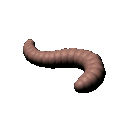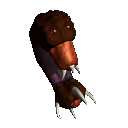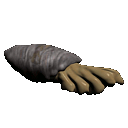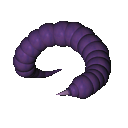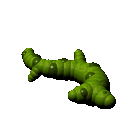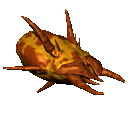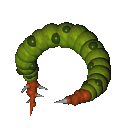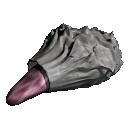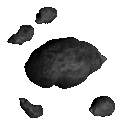www.pardus.at
| Overview | Index |
| Humanoids | Drones | Non-Sentient Life | Sentient Life |
| Biodegraders | Flora | Parasites | Serpents |
| Space Dragons | Swarms | Additional Sentient Life |
Biodegraders |
| Space Maggot | ||||
Disposition: Docile  Rarity: Common Region: Universal |
Space Maggots are undoubtedly the easiest prey in the universe. Their slow, sluggish movements, non-existent offensive capabilities, and soft outer membranes their only protection, they provide easy practice for inexperienced pilots looking to hone their skills. Leaving crafts caked with their inner ooze is the only real threat they pose to space pilots, leaving them unfortunately with a very large cleaning bill. | |||
| Bio Scavenger | |||||
Disposition: Docile  Rarity: Common Region: Universal |
Feeding upon all types of biological matter, as their name implies, Bio Scavengers are unique because they are speculated to be lifeforms native to no charted region of space due to their wholly unique genetic makeup. Believed to be carried back in the ballasts of barges returning from deep space exploration missions, these creatures are so dissimilar from anything science has yet to witness, they are presumed to be descendants of a completely divergent evolutionary ladder. Never has the question been raised so poignantly, since man first took to space, as to what new forms of life linger beyond what our eyes have seen. | ||||
| Space Clam | |||||
Disposition: Docile  Rarity: Common Region: Universal |
Like most biodegraders, the Space Clam is docile by nature, leading a solitary life searching for biological debris on the edges of energy fields. Despite their incredibly delicate build, Space Clams are not without defenses- an acidic slime squirted in the faces of would-be predators, and the unusual ability to channel a strong, sub-static vibration outward from its shell. Seemingly oblivious to everything around it, the Space Clam makes no effort to hide or otherwise avoid potential enemies, making them favored prey among many predatory life forms. This hyper-evolutionary creature will be forever remembered as one of the early harbingers of The Aperture, spreading rapidly through the universe. |
||||
| Space Worm | |||||
Disposition: Protective  Rarity: Uncommon Region: Universal |
Like Space Maggots, Space Worms are tasked with the humble job of clearing the universe of its cosmic waste. Considerably larger than their blobbish cousins, and considerably more aware, Space Worms have been known to grow aggressive when they, or specifically when their eggs, become threatened. Though invertebrates, they are crowned with a single bone-like spike made of solid tissue that they use to viciously defend their eggs with their lives if need be, only to abandon the newly hatched mere moments after their birth. | ||||
| Space Worm Albino | |||||
Disposition: Protective  Rarity: Uncommon Region: Universal |
An odd natural occurrence, Space Worm Albinos are occasionally sighted. Though otherwise genetically identical to normal Space Worms, save for their pigment deficiency, Albinos are yet another creature of great interest to many biologists. Extremely sensitive to UV light, the Space Worm Albino is also highly allergic to even faint traces of the Lucisti Virus that exist within the Pardus Cluster. Introduced to the Lucisti Virus, Space Worm Albinos are found to die within minutes, unlike their relatives which are transformed and mutated by it. Though still in the primary stages of study, researchers hope to use these non-aggressive creatures to understand the root cause of the Lucisti Mutations, and perhaps even one day the Lucidi. | ||||
| Mutated Space Maggot | |||||
Disposition: Docile  - Destructive - Destructive  Rarity: Uncommon Region: Pardus Core |
Unlike many of the other species mutated by the Lucisti Virus, Mutated Space Maggots have not lost sight of their original purpose within the life cycle. Innocently they continue their dutiful work, unaware of the change the virus has caused their bodies to undergo. Rather than secrete the nutrients required to sustain life, their altered bodies secrete an evolved form of the very virus itself, an ecological disaster by any means that places a heavy burden upon the remaining life within the Pardus Cluster. | ||||
| Eulerian | |||||
Disposition: Docile  - Destructive - Destructive  Rarity: Uncommon Region: West and South Pardus Rims, Split Cluster |
Found in nebula fields, the Eulerian get their unusual reddish-orange color from the ionized gas they feed on while slowly roaming. Once the resources are depleted in an area they move on to other nebula fields. Having a natural ability to hide in nebula, they pose a threat to any careless pilot that might happen to startle one. | ||||
| Mutated Space Worm | |||||
Disposition: Aggressive  - Destructive - Destructive  Rarity: Rare Region: Pardus Core |
The Lucisti Virus claiming yet another creature of the universe, Mutated Space Worms have become an all too common threat within the Pardus Cluster. Though researchers are unsure whether the Lucisti Virus altered these once docile creatures, causing them to be far more aggressive than they once were, or whether these pitiable creatures simply no longer understand their place in the cosmos, these Space Worms attempt to break down any and all matter, both living and dead. | ||||
| Space Snail | |||||
Disposition: Aggressive  Rarity: Common Region: Southeast from Pardus Core |
The bad boy of the biodegrading bunch, Space Snails' most devastating trait is their horrible temper. These aggressive creatures never take politely to unwanted guests who watch them dine, which is nearly every waking hour of the day. Their shells often composed of asteroid rock, and even the discarded metal of spacecraft, Space Snails become veritable tanks when coiled within them. Able to let loose thick globules of mucus, they are also known for ramming their husks directly into traveling spacecraft they view as a threat. | ||||
| Roidworm Horde | |||||
Disposition: Docile  - Destructive - Destructive  Rarity: Uncommon Region: Universal |
Intrinsically docile and harmless creatures, Roidworms carry out the same task as all biodegraders. Rather than converting organic waste into nutrients however, they secrete another building block of life, ammonia. Traveling in large swarms through space, the clouds these Roidworms produce are toxic to many forms of life in their highly concentrated state, poisonous to the living tissue of many creatures, and highly erosive to many types of metals. When attacked their bodies may explode violently, releasing an even more concentrated liquid form of this ammonia, causing further damage. | ||||
| < Sentient Life | | Up | | Flora > |
Last modification on this page: 2009-12-27

